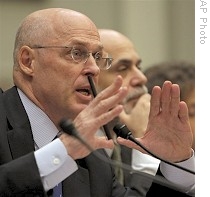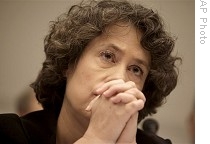voa标准英语2008年-Paulson, Bernanke Defend Financial Rescue Strat
搜索关注在线英语听力室公众号:tingroom,领取免费英语资料大礼包。
(单词翻译)
In testimony1 to Congress, the U.S. treasury2 chief and central bank chairman have strongly defended their management of the $700 billion financial and credit market rescue program. VOA's Dan Robinson reports from Capitol Hill, where the officials faced tough questions from lawmakers about how government money is being used. |
| Treasury Secretary Henry Paulson, left, accompanied by Federal Reserve Chairman Ben Bernanke, testifies on Capitol Hill before House Financial Services Committee, 18 Nov. 2008 |
U.S. Treasury Secretary Henry Paulson and Federal Reserve Chairman Ben Bernanke have faced criticism the original intent of the financial rescue program as approved by Congress in September has shifted.
Mr. Paulson revealed last week that billions of dollars approved by Congress is now going to prop3 up capital liquidity4 and lending capabilities5 of banks and other institutions, rather than to purchase troubled assets they hold.
Under questioning before the House Financial Services Committee, Paulson said negative developments in U.S. and global market conditions since Congress approved the rescue program outstripped6 the effectiveness of initial $350 billion amount approved by Congress, forcing the change in direction.
"It is clear that an effective mortgage asset purchase program would require a massive commitment of TARP [Troubled Asset Relief Program] funds," he said. "In September, before economic conditions worsened, $700 billion in troubled asset purchases would have had a significant impact. But half of that sum in a worse economy simply is not enough fire power."
Paulson said actions so far had strengthened the financial system, prevented further harm to the U.S. economy, and preserved for President-elect Barack Obama the flexibility7 he will need to deal with future challenges.
Committee chairman Democratic Representative Barney Frank said lawmakers are unhappy with how banks and institutions have used money from the government program, and their failure to significantly expand lending to home owners.
"The fundamental policy issue is our disappointment that funds are not being used out of the $700 billion to supplement mortgage foreclosure reduction," he said.
Lawmakers have pointed8 to media reports that banks have used money from the government assistance program to purchase other banks, and pay investor9 dividends10 and bonuses to executives.
Representatives of some major institutions told Congress last week that executive compensation will be sharply reduced in light of economic conditions, and defended their efforts to expand lending.
Ranking panel Republican Spencer Bachus said Paulson deserves credit for recognizing the need to shift strategy.
"[If] conditions on the ground change, then you must be agile11 and adjust, and I hope we all understand that," he said.
In their testimony, Bernanke and Federal Deposit Insurance Corporation Chairman Sheila Bair said while capital injections reduced pressure on and provided some stability to banks, credit conditions remain unsatisfactory.
"Overall credit conditions are still far from normal, with risk spreads remaining very elevated and banks reporting that they continued to tighten12 lending standards through October," Bernanke said.
 |
| FDIC Chairwoman Sheila Bair testifies on Capitol Hill before the House Financial Services Committee, 18 Nov. 2008 |
"The financial system is now more stable and interest rate spreads have narrowed substantially, however credit remains13 tight and a serious threat to the economic outlook," said Bair.
Bair pointed to continuing increases in the number of U.S. home foreclosures, saying that government efforts are "falling behind the curve."
In his testimony, Treasury Secretary Paulson said the Bush administration remains opposed to using funds from the government rescue program to help the three major U.S. automakers avoid collapse.
House and Senate lawmakers are considering a $25 billion plan to help auto14 manufacturers.
 收听单词发音
收听单词发音 




